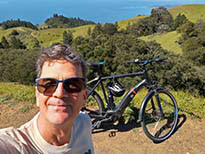* * *
"My impression is that the critique of, or at least the rethinking of, the whole business of the sublime and the beautiful in American landscape photographs began around the time of Robert Adams's The New West in 1974.... All of that work was read as a reaction against the work of Ansel Adams and Eliot Porter, against what might be called the Sierra Club photographers."
-- Robert Hass, in What Light Can Do
On the recommendation of a friend, I went to the library to pick up Robert Hass's award-winning book, What Light Can Do -- Essays on Art, Imagination, and the Natural World. (He recommended purchasing it so you can make notes in the margins and keep returning to it.) Much of it is too cerebral for me, but I'm still finding plenty worth perusing. The section on photographers includes an essay on Robert Adams, whose vision of nature never appealed to me before I saw the sample photos in this book and read what Hass has to say about them.
As I started shooting this morning, first pulling over to photograph the rising sun through the chaotic tangle of forest, and then stopping to pay attention to a lone, desiccated thistle, I imagined I was channeling a photographer with a very different aesthetic than my own. It was an interesting -- I hate to call it an exercise because it felt more natural than that -- but an interesting point of view to adopt. If we can observe our own egos, we have a chance to alter our habitual ways of seeing. We can loosen the reins and see the world anew.
I was surprised to find when I got home and processed my images that I actually liked the weird sunrise-through-the-forest, and even the lone thistle. But just west of the thistle, just a head-turn away, a scene was unfolding that pulled me right back into my usual pattern of seeing, which I also welcomed.
I've tried to break out of visual ruts before by doing photography in places like downtown San Francisco, or perusing the work of other photographers.
I knew I was on a roll with the whole business of rut-scuttling when I deigned to photograph the nasty invasive flower called yellow star thistle (Centaurea solstitialis). "Better kicked than picked" is a term of endearment for certain inedible mushrooms, and I've always felt that way about star thistle: better pulled up by its roots than photographed. But at least the light was nice.
My plan for the day had been to park at Rock Spring and hike down to Laurel Dell to try to photograph migrating songbirds that might pass through that area since there's at least a little water and shade there. But after I'd hustled through the star thistle patch I realized the light was still pretty good on the larger landscape and explored the possibilities. It's been several weeks, maybe a couple of months or more, since I've had such a fog-free view back toward San Francisco.
This grandfather oak tree provided excellent shade and was turning out some very fat, green acorns.
This is the same tree, on the other side of the trunk.
Scruffy September stuff, with one of the big oaks in the background.
I'd been hoping to see the year's new flock of California quails and was treated to a covey foraging by the side of the road.
They were skittish, though, and took to the trees when I tried to approach.
Running this way.
And that way.
Looks so nice I have to shoot it twice.
My socks collected an incredible number of grass seeds while I followed these turkeys around.
I felt like I was having a pretty good day of photography despite the tyranny of expectations I'd imposed on myself before I left home. Here's how the tyranny of expectations works. It's a little after 5 a.m., and you're lying in bed trying to decide where you want to go to do some photography, and whether there actually is anyplace good since you've "seen it all before" and, by the way, it's going to be a scorcher of a day with temps in the 90s.
That whole Zen thing about "beginner's mind" -- isn't that just a nice slogan, a clever quotation?
I don't know, but going up this morning without expectations worked so well that I'm afraid I'll jinx it just by talking about it.
The thing is, I spend pretty much the whole workweek in downtown San Francisco on the fourth floor of a sealed, climate-controlled tower of steel and glass. Even if I didn't take my camera out of the bag, I'm still going to have a good day if I can get up to Mt. Tam on the weekend.
So I was poking around the internet the other day and found another Mt. Tam blog (see "Mt. Tam Links" on the sidebar). Like this one is going to be, it was a one-year project. I enjoyed scrolling through the pages, reading and taking note of various mountain-viewing vantage points.
By this time in my wanderings I'd circled back around to Cataract Creek (where the water striders are getting really nervous in their few remaining puddles) and put my ear to the woods. Chickadees, check. Juncos, check. Acorn woodpeckers, check. Not too much action on the migrant front, though. It was only about 9 a.m. -- I'd only been up there about two hours -- but it was already getting hot, and my t-shirt was soaked. I figured I might as well save Laurel Dell for another day.
* * *







































































